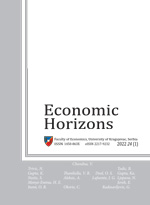REPUBLIC OF SERBIA’S ECONOMY AFTER THE GLOBAL RECESSION OF 2020: STRUCTURAL PROBLEMS IN THE SHADOW OF GROWTH
Edvard Jakopin1, Aleksandar Gračanac2
1University “Union - Nikola Tesla”, Faculty of Economy and Finances, Belgrade, The Republic of Serbia
2University “Union - Nikola Tesla”, Faculty of Entrepreneurial Business and Real Estate Management, Belgrade, The Republic of Serbia
After the COVID-19 pandemic-induced global recession of 2020, the Republic of Serbia achieved one of its highest growth rates in 2021 in the past two decades of transition, that rate being 7.5% (only in 2004 was a higher 9% growth rate achieved). At the beginning of 2022, however, Europe was faced with a new global upheaval caused by war in Ukraine with unpredictable economic consequences. Inflationary pressures have been increasing, primarily due to the strong growth of energy and food prices. The effects of global recessions reflect in the slowdown in structural reforms in all transition economies. The paper investigates the structural performance of the growth of the Serbian economy between the global recession and the slowdown in growth. A special accent is placed on the analysis of structural problems, the solution of which was in the shadow of economic growth.
Keywords: economic growth, global recession, structural changes of the economy, structural economic problems
JEL Classification: O11, O47, E6, F6




